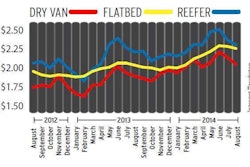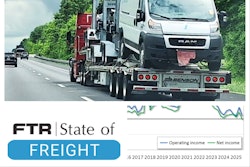You might recall news from June about a matchmaking service that flew 16 single women from New York City to San Francisco for a long weekend of meeting bachelors. The dating service had noticed large imbalances among clients: too many women in NYC, too many guys in San Francisco, many of them highly eligible Silicon Valley techies.
 Real-time data is providing “a window into the trucking industry that we’ve never really had before,” says transportation analyst John Larkin.
Real-time data is providing “a window into the trucking industry that we’ve never really had before,” says transportation analyst John Larkin.Savvy independent owner-operators are using a similar geographic application of supply and demand, as explained in a story by Senior Editor Todd Dills. That is, they’re learning to identify markets seriously lacking in truck capacity, yet with plenty of freight. Such areas can yield a match made in heaven in terms of rates.
Unlike gender ratios in NYC and San Francisco, balances of trucks and freight are not static. In agricultural regions, freight changes are seasonal. In others, they change much more quickly.
Nothing new there, but what has emerged through the years is the ability for owner-operators to quickly and accurately pinpoint the markets where they’re in high demand, even before arriving. Load-matching services, notably Internet Truckstop and DAT, offer data-analysis tools with their subscriptions that detail current market conditions by city or other geographic specifications.

This gets at the heart of one of owner-operators’ biggest complaints: the greedy broker who books a load at a bad rate, perhaps even a decent rate, but one that’s a windfall for the broker because of an extraordinarily high demand situation.
It boils down to information. The broker, historically, has known the current market conditions; the owner-operator hasn’t.
That great divide is narrowing steadily, thanks to the availability and level of detail of the market data now accessible to independents. This development has spanned years, but what’s happened since just this past winter is the big shift of contract freight to the spot market, where independents often have operated. Dills details several reasons for this in his story.
The convergence of these trends can be a gold mine for the independent who’s not afraid of online research, who’s willing to put in some extra time and who can negotiate for optimal rates. Real-time data is providing “a window into the trucking industry that we’ve never really had before,” says transportation analyst John Larkin of Stifel Financial Corp.
Operating under your own authority has long been the way to earn the best money as an owner-operator. It’s also always been the riskiest, subject to economic developments beyond the operator’s control. Running independent remains risky, but thanks to today’s data tools, the operator can reduce that risk, gaining a measure of control that has never existed.












